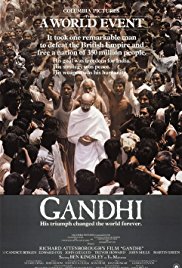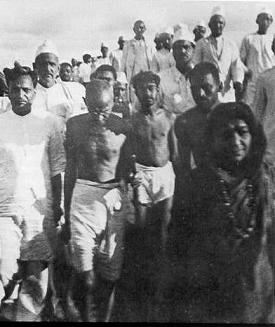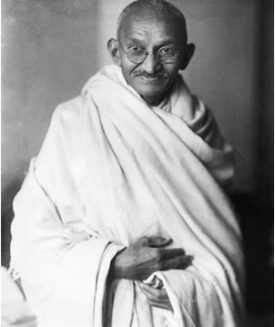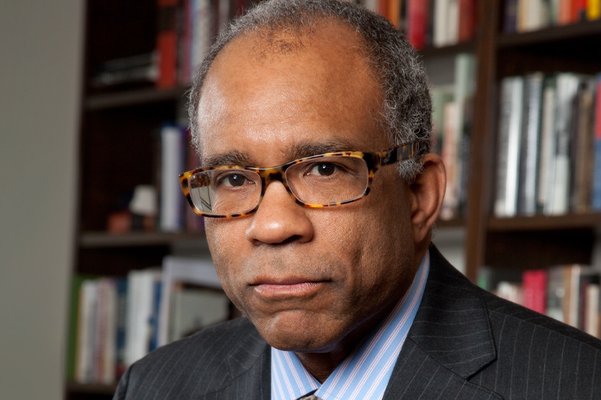1. Briefly describe the British Empire as it existed after World War I.
Suggested Response:
The British Empire was one of the great empires of the world, lasting from the 1500s to the middle of the 20th century. It was the world’s largest colonial empire. At its height, after World War I, it contained possessions in every continent, covering more than 20 percent of the world’s land area and governing more than 400 million people.
2. Early in his career Gandhi described campaigns of nonviolent mass action as “passive resistance.” Later he had second thoughts about this description. Does the term “passive resistance” accurately describe a campaign of nonviolent mass action? Explain your answer focusing on each of the two words of the phrase.
Suggested Response:
Nonviolent mass action is very active. However, it is not violent and that is how the term “passive resistance” came into use. Passive resistance has its most poignant and impressive example when nonviolent activists do not fight back when assaulted by police or thugs determined to maintain the status quo.
3. Early in his career Gandhi described campaigns of nonviolent mass action as “passive resistance.” Later he had second thoughts about this description. Does the term “passive resistance” accurately describe a campaign of nonviolent mass action? Explain your answer focusing on each of the two words of the phrase.
Suggested Response:
There is no one correct answer. A good answer will show an understanding of the nature of nonviolent mass action. What follows is a sample response that covers all the bases. A good response would include half of these concepts: Yes and no. The word “passive” is accurate in that nonviolent resisters don’t physically strike their opponents. However, “passive” is not accurate in the political, emotional, or moral sense. Persons involved in nonviolent mass action are seeking to change political or social reality, usually in a very aggressive way. They are making things very emotionally difficult for their opponents. Nonviolent mass action seeks to make people look at their actions or their beliefs with a new ethical perspective. It challenges long held beliefs and established customs of behavior. In this sense, the word “passive” is incorrect. The word “resistance” is also both appropriate and inappropriate. A nonviolent protester “resists” the normal operation of the status quo in an effort to make it grind to a halt or in an effort to change it. At the same time, this “resistance” is very dynamic because it seeks to create change, often dramatic change. Thus Gandhi, in South Africa, “resisted” enforcement of the pass laws for the purpose of fundamentally changing society to improve treatment of people of Indian descent.
4. What benefits have the people of the United States, black, white and others, derived from the influence of Mahatma Gandhi?
Suggested Response:
Gandhi provided tactics and a theory by which the black community in the U.S. could challenge the unethical practice of segregation and make the whites realize that it was wrong. It provided a means to force social change without violence. The Civil Rights Movement has enriched the ethics of the United States and made it less hypocritical. All Americans are its beneficiaries, for while black people obtained freedom from the restrictions of segregation, whites and other Americans (to the extent they learned from the Civil Rights Movement) freed themselves of the unethical conduct called segregation and brought their society more in line with the principles of the Declaration of Independence. The benefits were immense for both. As for other minorities, the prohibitions on racial segregation have also outlawed discrimination against them and they have benefitted from the understanding of the evils of racism that grew out of the Civil Rights Movement.
5. Methods of nonviolent mass action can be separated into three categories. Name the categories and give at least two examples of each.
Suggested Response:
They are: (1) protests (such as petitions, meetings, parades, vigils, and demonstrations), (2) noncooperation (such as boycotts, resignations and work slowdowns) and (3) direct intervention (such as sit-ins, factory occupations, seizures of property, and blockades).
6. What are the three main ways in which nonviolent mass action forces political and social change? These can be thought of as the sources of its power. Describe how each of the three works.
Suggested Response:
Nonviolent mass action: (1) changes hearts and minds; (2) hurts the pocketbook of those whose behavior it seeks to change; and (3) prevents those whose behavior it seeks to change from going about business as usual. They work in the following manner: (1) Changing Hearts and Minds: nonviolent mass action works on the ethical perspective of the majority and the powerful by challenging the morality of their conduct. It points out contradictions among the values of the powerful or of the majority. It highlights differences between their actions and the society’s values. When the hearts and minds of the majority are changed, modification of policies and actions will naturally follow. Even if the entrenched powers are not convinced, it is difficult for governments or ruling elites to enforce policies rejected by the general public. (2) Applying Economic Pressure: mass nonviolence puts economic pressure on the ruling powers through boycotts or other economic sanctions that hurt some of the ruling elite economically. This pressures and divides the ruling powers. (3) Preventing Business As Usual: Finally, by making the administration of the government or the functioning of society more difficult, nonviolent mass action pressures target groups to make concessions.
7. Would the tactics of nonviolent mass action have worked against Hitler, Stalin or Saddam Hussein?
Suggested Response:
There is no one correct answer to this question. A good answer will show an understanding of the mechanics of nonviolence and the difficulty that it has in operating against abject evil. Certainly, if nonviolent mass action is to work against a vicious dictatorship, it would have to be substantially modified. For example, the Danes, who used nonviolent mass resistance to fight the Nazi occupation of their country during WWII, modified Gandhi’s principles by using secrecy in spiriting their Jewish countrymen to Sweden, in their work slowdowns, and in their general strike. In addition, because of the nature of their oppressor and because the world was at war, the pressure of public opinion in other countries was not a weapon that would help them. However, the fact that the Nazis needed the goods produced in Denmark’s factories for the German war effort meant that they would be somewhat circumspect in their efforts against masses of Danish workers.
8. How does nonviolent mass action work on the mind of the oppressor?
Suggested Response:
The mechanisms of nonviolent mass action expose the abuses of the oppressor and subjects the beliefs and actions of the oppressor to scrutiny. If the nonviolent mass action campaign is well conceived it exposes contradictions between the oppressor’s underlying values and the values served by the oppressive actions. In a successful campaign, the oppressor, often also responding to aroused public opinion and economic pressure, will change its policies. Thus, in the U.S. the black minority made the white majority face the contradictions between the ideals of the Declaration of Independence and the practices and beliefs of racism. Faced with this contradiction, propelled by an aroused national public opinion, and harassed by economic pressures caused by boycotts, sit-ins and other economic tactics, enough segregationists changed their position so that both government policies and social practices were modified.
9. What was meant by the term “divide and rule” and how did this apply to India?
Suggested Response:
This was a tactic used by the British to govern large populations with few forces. They did not allow the populations to unite and combine against British occupation. In India one of the divisions used by the British was the division between Muslim and Hindu. It was effective for the British for a while but the effects on India and Indians were disastrous.
10. Did Gandhi think of himself as a saint?
Suggested Response:
No. Gandhi described himself as a politician trying to be a saint, that is, he was a politician first. While he preached internal discipline and morality, Gandhi was primarily focused on political and social goals. He was an activist and politician who tried to act in a saintly manner, thereby raising the level of ethical conduct of everyone concerned, to achieve independence for India without bloodshed and war.
11. Gandhi said “We must not hate the British. They have not taken India from us. We have given it to them.” What did he mean by this and how does it apply to any revolution through mass nonviolent action?
Suggested Response:
He meant that if the Indians withdrew their cooperation from the British Empire, it could not function in India and the British would be forced to leave. No government, whether it is a dictatorship or a democracy, can last if the people withdraw their consent to be governed and stop obeying government orders. As Gandhi said: “Authority enjoys power only to the extent that obedience is rendered by the population.”
12. If nonviolent protesters are attacked by the police or other opponents, what should they do?
Suggested Response:
They should not fight back. Some strategies of nonviolent mass protest provide that the protesters should not even try to protect themselves from the blows, others permit them to move their bodies to protect vital organs but not to strike back.
13. James Lawson, a leader of the Nashville sit-ins which applied Gandhi’s principles of Satyagraha, said that the first step in Gandhian nonviolence was “to research and examine and focus on an issue: choose a target [and then] choose an issue.” This movie shows Gandhi doing this with respect to protests in India. What did he do?
Suggested Response:
He retired to his ashram to meditate and came up with the idea of the salt march. Other possible correct answers include references to Gandhi’s decision to spin cloth to break the Indians of their dependence on cloth made in factories in Britain and his focus on the treatment of the untouchables.
14. When the British were resisting independence for India, they wanted Gandhi’s supporters to get angry and become violent. Why would that have hurt Gandhi’s campaign?
Suggested Response:
It would have denied Gandhi and his followers the advantage of the moral high ground and it would have given the British an excuse for their violent repression of the protests.
15. What is the role of the press, foreign and domestic, in a campaign of nonviolent mass action?
Suggested Response:
The press spreads the message of the protesters and distributes the news of the repressive and violent actions of those in power. This will hopefully mobilize public opinion for the goals of the protesters and against those in power. It is difficult for any government to resist an aroused public opinion. Thus, even if those in power do not become convinced by the arguments of the protesters, they will at the least be influenced and perhaps compelled to change their position. Foreign press is especially important when the domestic press is controlled by the government or when the government is not responsive to the people. India and South Africa are particularly good examples of the powerful role of the foreign press.
16. What is the role of economic boycotts or other financial pressures in nonviolent mass actions?
Suggested Response:
There are two purposes. The first is to compel the oppressive forces to give in, even if they are not convinced by the arguments of the protesters. The second is to divide the opponents. Usually, boycotts and economic measures hurt one segment of the power structure more than they hurt others. This divides and weakens the opponents. As the British taught the world, “divide and conquer” is an amazingly effective tactic. Nonviolent protesters use it, too.
17. How have changes in communication technology affected the kinds of power that nonviolent movements and the regimes they oppose can exercise? What new tactics, for instance, might a present-day Gandhi employ in the era of the internet, cell phones, and email?
Suggested Response:
There is no single correct answer to this question. A good answer will mention the various changes in communications technology, computers, and the increased power of government to spy on its citizens (“big brother”). A good answer will point out how improved communications and computer technology will make it easier to mobilize masses of people and communicate with the press or, using the Internet, directly with the audience. A good answer will demonstrate some knowledge of the mechanics of nonviolent mass action when evaluating the new technologies.
18. Gandhi said that the only devils in the world are those running around in our hearts. What did he mean by this?
Suggested Response:
If people didn’t allow themselves to be possessed by hatred, greed etc., there would be no evil in the world. For those who believe in the devil, another interpretation is that if people didn’t allow the devil to possess their souls and govern their actions, there would be no evil in the world.
19. During the Hindu/Muslim riots shown in the film, one man came to Gandhi and asked for help. The man said that he had killed children of the other religion and that he knew he would be condemned to hell for that. What advice did Gandhi give him?
Suggested Response:
Gandhi advised him to adopt an orphan of that other religion and to raise the child as his own, but to make sure that the child practiced the religion he or she was born into. That selfless act could help the questioner at least partially redeem himself.
20. (a) Who were the untouchables? (b) What did Gandhi want to do for them? (c) Why did Gandhi think that this was especially important for Indians?
Suggested Response:
(a) Indian society was (and to an extent still is) very stratified. The untouchables are at the bottom of the caste system. They had the most degrading jobs, such as cleaning latrines, picking up corpses of animals and people and then working in tanning factories. Hindus of higher classes would have to go through a ritual cleansing if they touched an untouchable. (b) Gandhi wanted to end discrimination against the untouchables. (c) Gandhi felt that the majority of Indians had to get their own house in order, i.e., to stop oppressing other people.
21. Gandhi believed that the effort to improve the social status and condition of the untouchables had some similarities to the Indian movement for independence. There were at least two. What were they?
Suggested Response:
The first was that the relatively powerful (the majority of Indians) were oppressing the relatively powerless (the untouchables). The second similarity was that this needed to be changed.
22. What parts of Gandhi’s character would you like others to emulate and what, if any, do you find fault with?
Suggested Response:
Gandhi’s most striking character traits were (1) his refusal to hurt other beings, both human and animal; and (2) his activism in politics. He apparently could have been a better father and there were problems with the way he treated his wife.
23. Which comes first in a democratic society, attempts to work through the democratic process or nonviolent mass action? As a campaign on nonviolent mass action moves forward, what, if anything, is the role of the democratic process?
Suggested Response:
First and continually one should work through the democratic process. It is only if the democratic process is not responsive that resort to nonviolent mass action should be taken. While nonviolent mass action progresses, the democratic process should be pursued at the same time. The relationship between them is that the democratic process is the normal way to proceed and only when that is not working should nonviolent mass action be added to exert additional pressure for as long as necessary.
24. In 1967 Israel inflicted a humiliating defeat on Arab armies in the Six Day War. Citing the need to defend itself from invasion, Israel occupied the West Bank of the Jordan River and the Gaza strip. The Palestinians have sought a separate country and have demanded that the Israelis end their occupation. They have concentrated their efforts to force the Israelis to withdraw on a combination of terrorism, violent demonstrations, international political pressure, and a media campaign seeking to change public opinion. They have not mounted a campaign relying upon nonviolent mass action. The Israelis have responded with sometimes brutal force which they justify as necessary to counter the violence of the Palestinians.
Most recently, in May of 2021, Hamas fired more than 4000 rockets into Israel indiscriminately targeting civilians. Only Israel’s great technological superiority through its “Iron Dome” defense system prevented massive damage and large civilian casualties on the Israeli side. Again, the Israeli’s responded with massive force, destroying large parts of Gaza and killing more than 200 people, including civilian adults and children. The death toll would have been many times higher except that before bombing a building, the Israeli Defense Force would call the inhabitants and warn them of the impending attack, telling them to leave.
Here is the question. Would it be more effective for the Palestinians to renounce violence and engage in the type of nonviolent direct action pioneered by Mahatma Gandhi?
Suggested Response:
TWM expects that people on all sides of this question will take strong exception to even the way we have asked the question, let alone the suggested answer. However, before you condemn us, put yourself in the position of a person on the opposite side from you and think about how they would object to this question.
Here is our suggested response. No one knows for sure but based upon the experience of the South African resistance to Apartheid, the American Civil Rights Movement, and other social/political campaigns that have rejected violence and gone on to prevail, a strong argument can be made that the most effective way for the Palestinians to improve their situation and reach at least some of their political goals would be to engage in nonviolent mass action. Israel is a Western-style democracy. Even though it has been faced with terrorism from the Palestinians, it has had a strong peace movement. (Several Israeli prime ministers for example, Rabin, Barak, and Sharon, have made peace with the Palestinians and a return of the conquered territories a hallmark of their foreign policy.) Had the Palestinians renounced violence and convinced the Israelis of their peaceful intentions, the Israelis would have been much less reluctant to grant accommodations to the Palestinians. In addition, Israel depends upon the U.S. for support in the international community, for billions in foreign aid, and for many of its weapons. Had the Palestinians not been shooting missiles and sending suicide bombers into Israel, there would have been tremendous pressure on the Israelis to make an accommodation with the Palestinians.
Many people condemn the force of the Israeli response. However, they need to answer this question. What would happen if Canadians were lobbing rockets indiscriminately into Juneau, Alaska or Detriot, Michigan, killing civilians and destroying buildings? There is only one answer, the response of the U.S. armed forces would be massive and brutal.
The world has seen many examples of nonviolent mass action resolving entrenched conflicts: here are just a few: Apartheid in South Africa, the U.S. Civil Rights Movement, the Indian independence movement, the campaign for women’s suffrage in the United States (see the Learning Guide to Iron Jawed Angels), the ouster of the dictator Ferdinand Marcos in the Philippines, the dissolution of the Soviet Union in 1991, the Rose Revolution in Georgia, the Velvet Revolution in Czechoslovakia, and many more. See generally, Wikipedia Article on Nonviolent Resistance https://en.wikipedia.org/wiki/Nonviolent_resistance and the TWM Guide on A Force More Powerful.
Of course, there are many unique qualities of the Palestinian/Israeli conflict and many difficulties in seeking a resolution. The Palestinians will have to compromise many of their cherished goals. They will need to accept the existence of Israel and they will need to modify their demand for the “right of return.” The Israe,lis, for their part, will have to pull back settlements, deal with the extremists in their own society, and change the way they treat Palestinians.
However, after all these decades isn’t it clear that violence is a dead end for everyone – literally. Are the problems between the Israelis and the Palestinians any more intractable than all the problems that have been solved by nonviolent mass action? It is said that one definition of insanity is trying the same thing over and over again and expecting a different result. Isn’t it time, after seventy years of the failure of violent confrontation to try another way?
And more importantly, nonviolence is an ethically superior way to deal with conflicts. Violence is evil, however, it is excused in certain limited situations, such as self-defense, defense of country etc. But that is an excuse used to justify something that is inherently evil. The morally superior position is that of Gandhi and Dr. Martin Luther King – to be nonviolent in the first place.
For the discussion questions in the form of a comprehension test, suitable to be printed and distributed to a class, see Comprehension Test/Homework Assignment for “Gandhi”. Note that the test assumes that the concepts underlying the questions have been discussed in class.









